Macros for Gaining Muscle and Cutting Fat
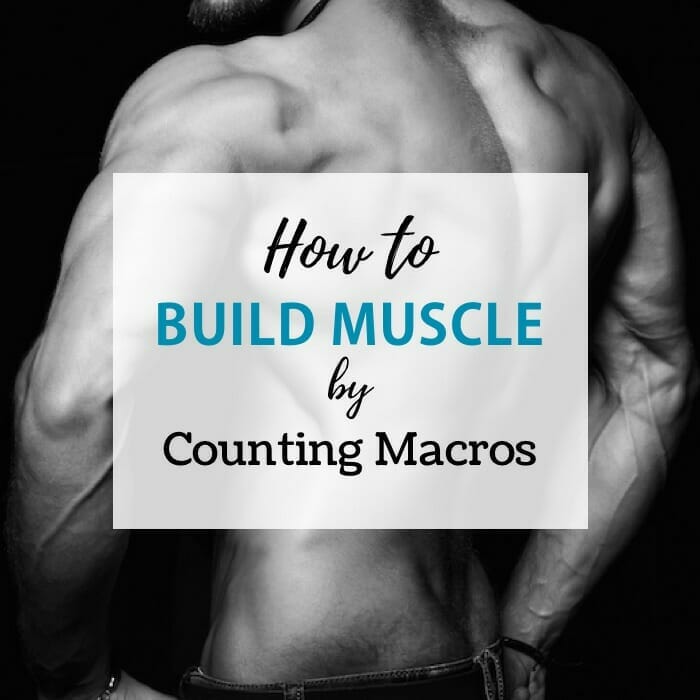
One of the most frequent questions I receive as a macros coach is from someone wanting to know if they can gain muscle and lose fat at the same time on a Macros Diet.
This can be a bit tricky, but lean muscle gains can be accomplished with counting macros.
As long as you are patient and willing to put in a little extra effort with both nutrition and training aspect of flexible dieting.
How to Calculate Macros to Gain Lean Muscle (Bulking)
Traditional bodybuilders use two phases to build muscle and then lose fat:
- Bulking: which is to eat a calorie surplus while engaging in comprehensive weight training with some fat tissue also gained.
- Cutting: which involves reducing calories drastically and often includes either a very low-fat diet or ketogenic-type diet while engaging in comprehensive weight training.
The above method can grow muscle relatively quickly and can also remove fat relatively quickly, but it probably isn’t realistic for most, especially those who are not athletic and already have a fair amount of fat to lose.
Most of us want to gain muscle and lose fat at the same time instead of in two separate steps. This is possible as long as you do things correctly.
Steps to Calculate Macros for Fat Loss and Muscle Gain (Lean Bulk)
- You must maintain a sensible calorie deficit. Too drastic and your muscles won’t grow, too little and fat loss will be extremely slow.
- You have to have a comprehensive weight training program in place. This can be weight training, Crossfit, boot camps, etc. but you have to be constantly breaking down muscle tissue, giving it time to repair, and then pushing muscles a little harder to break tissue down the tissue again.
- Your diet must contain the raw materials for muscle growth. Adequate protein and nutrition that will induce enough protein synthesis to outweigh protein breakdown.
- Your hormonal levels must be in balance. Both fat loss and muscle growth rely on hormones to release fat stores and to build muscle tissue. The best way to achieve healthy hormones is to eat a healthy nutrient-dense diet, get plenty of sleep, and to exercise regularly.
Consider hiring a nutritional coach
Since building lean muscle can be a balancing act, Consider hiring me as your nutritional coach.

- I’ll claculate the optimal lean gains macros for you.
- I’ll monitor your progress and update your macros as needed.
- I’ll help you with meal planning.
- You get all my books and resources.
- 24/7 email support.
- Zoom calls
- Weekly check-ins.

Ted helped me understand the process, have the right mindset, and introduced the right structure that I was looking for in terms of my nutrition. I started at 191 pounds and I’m now between 162lb and 165lb, and I can’t thank Ted enough. I’m 3 months from my 50th birthday, and still on track and enjoying the process more and more.”
Jaime – Lost 29 pounds, gained lean muscle.
“..the advice you gave me was spot on and I gained a ton of muscle. “
Lindsay M.
Setting Your Macro Ratio to Build Muscle

Again, a macro-based diet is conducive to this process for several reasons.
- It places you in a moderate calorie deficit based on your exercise adjusted TDEE: This amount encourages the breakdown of fat for extra energy.
- It allows you to adjust your protein amount in a way that provides muscle tissue the raw materials needed for growth.
- It adequately fuels your muscles so that your workouts can stress your muscles to the point of muscle trauma, which is essential for growth.
First, calculate the best TDEE for your muscle gain goals.
There are two goals: gain overall weight (suitable for those who may be underweight) or exclusively gaining muscle mass.
Overall weight gain: a person should consume 20% more calories than their maintenance TDEE.
Lean muscle gain: a 10% increase in calories is a good place to start and must be partnered with a comprehensive weight lifting program.
Muscle gain while losing fat: a 10% calorie deficit is a good place to start and must be partnered with a comprehensive weight lifting program.
While your macros fuel your transformation, I can’t stress the importance of proper exercise. Weight-bearing exercise actually enhances fat loss as well as promotes muscle growth.
Next, calculate your muscle gain macros.
There can be several optimal macro ratios for gaining lean muscle but the most important aspect to consider is your protein intake.
Most people want about .8 -1 gram of protein per pound of body weight. Our macro calculator allows you to adjust your protein appropriately.
Second, you want to consume adequate carbs. Your muscles need stored glycogen for the explosive strength weight lifting demands, therefore you need to eat enough carbs to replenish this supply each day.
Thirdly, you want to consume 25-30% of your calories as fat. Your body needs healthy fat for hormone production and cellular repair so be sure to eat some fat each day.
Do you need alot of calories to build muscle?
This is a common misconception. While your body can’t create mass from nothing, you also don’t have to be in huge calorie surpluses for muscle development. In fact, your body can only add a finite amount of growth per day so if you’re consuming a lot of extra calories, your body will also store that extra energy as fat. It’s better to start conservatively and work up from there, opposed to eating a lot and then cutting back.
Can you build muscle on maintenance calories?
This may be a good approach for some people if they are eating enough protein and have some fat reserves to compensate for the extra energy required. However, this wouldn’t be a great approach for guys who are already really lean or people with a higher body fat percentage.
If you want to go a little deeper, here’s what’s involved physiologically when it comes to fat loss and muscle building.
Physiology of Fat Loss
Most people understand that fat storage is a survival mechanism that the body uses to store energy in case of periods of famine. Thousands of years ago this mechanism was vital to our survival as a species because since we hunted and gathered for food, sometimes humans would have to go days or even a week before adequate food was obtained.
Now fast forward to our modern times where food is abundant and little energy is expended to get that food beyond pushing a cart around the grocery store. Our bodies are still hardwired the way they were a thousand years ago.
- Excess food energy gets stored in the form of fat.
- Fat stores are broken down when the body needs energy it isn’t getting from enough food.
Unfortunately, the body doesn’t have an off switch and fat storage is accumulative. What’s worse, it is far easier to store fat than it is to release fat because we are hardwired to enjoy food as a way to also ensure our survival.
So, to lose fat you have to be taking in less energy than you are expending during any given day.
To make up for the calorie deficit that you are in, your body has to begin breaking down fat for the energy required. There are a few caveats to this and I’ll address those a little later, but in a basic sense, this is why we store fat and how we lose it.
Physiology of Muscle Growth
Biologically, muscle tissue is functional tissue in that it exists to serve a purpose and the extent to which it exists is dependent on the body’s need for it.
The body has no interest in partitioning energy to muscle growth and development unless it believes that the extra muscle is required for our survival, whether in reality or artificially contrived (the gym).
Thousands of years ago humans had to work hard for their survival; hunting, building, farming, laboring, etc. and muscle development occurred more naturally.
Today, while some do still labor, most of us have more sedentary type lives which means that the minimal amount of skeletal muscle is required for our survival.
This means that simply eating more will not result in muscle gain. Since more muscle isn’t needed, extra energy will be stored as fat as I previously described.
In order for muscle tissue to grow1, it has to be stimulated in a way that breaks or injures muscle fibers (muscle trauma) so that they are rebuilt stronger with the help of key hormones and amino acids (protein synthesis)2.
Also, the rate of muscle protein synthesis has to be greater than the rate of muscle protein breakdown caused by the trauma, therefore a person’s diet must contain the raw materials needed for protein synthesis.
Since most of us don’t naturally undergo the type of activity that causes muscle trauma in our jobs, we have to simulate this at the gym with strength training and/or weight training.
Therefore, muscle growth in its basic sense requires the right diet and the right exercise.
Research reveals3,4 that exercised muscle causes the hormone irisin to be released, which in turn, causes the formation of brown fat. Brown fat5 actually burns fat instead of storing it.
Therefore, a weight training program of some sort has to be used in conjunction with the dietary recommendations of counting macros.
Measuring Muscle Gain Progress
Using a scale isn’t the best measure of your progress concerning how well you are losing fat and gaining muscle.
Muscle tissue is far denser than fat tissue, so the same volume of muscle weighs much more than the same volume of fat. Therefore, the numbers on the scale may only be going down ever so slightly as you build muscle or vice versa.
Taking progress pictures as well as measuring your body fat percentage are both a much better gauge of your progress. Get yourself a cheap set of body calipers and use our body fat percentage calculator. Take selfies in the mirror or get your friend or partner to take the pics using the same settings and location each time.
Also, make sure you have realistic goals in place. Here’s how body fat percentage breaks down in both men and women.

Can you gain muscle when cutting (losing fat) at the same time?
I’ve had great success using flexible dieting/ counting macros to lose fat and build muscle simultaneously. (You can read my story here.)
If you are coming from years of low-calorie dieting or yo-yo dieting, your hormones could be out of balance especially the leptin group6. It can take a period of normal, healthy eating for things to normalize again. Be patient during this process.
Macros aren’t “one size fits all” so you may have to spend some time adjusting your TDEE and macros until you find YOUR personal sweet spot for muscle growth and fat loss.
Our calculator gives you just a great starting point, but it may be helpful to get the help of a good macro coach to dial in your macros more accurately.
For me personally, I found that eating according to how much activity I do each day opposed to eating the same activity averaged set of macros each and every day has worked best. On rest days I eat at my sedentary weight loss levels.
At the gym, you need to be adamant about continually challenging and pushing your muscle groups. This usually means adding more weight to your movements consistently. Doing a lot of reps increases endurance and strength, but doing more weight increases size, so if more size is what you’re after, focus on heavier weights.
I’m also a fan of full-body workouts as opposed to isolating muscle groups when trying to build muscle and lose fat at the same time. Here’s my theory as to why. Since you are in a calorie deficit you have to be careful that your body doesn’t break down muscle tissue for resources7 instead of fat. Working out only arms could put you at risk of your body cannibalizing your legs for extra energy/protein for example.
By doing whole-body workouts, you are stressing almost all your muscle groups, so your body will be less likely to rob Peter to pay Paul so to speak. Consuming adequate protein also helps prevent this and is essential. I also like to have 2 days of rest in between my whole body workouts and on those days I do cardio type activities.
Overall, I can’t stress the importance of being patient. Macro dieting is designed to produce slow and steady results and the same is true for the process of losing fat and gaining muscle at the same time.
Accelerate Your Diet and Fitness Goals with My Macro Solution System
Step-by-step self-guided program -or- fully customized personal macros coaching. Feel exhilarated as you conquer your goals!
MACRO COUNTING
- 130 page step-by-step guide.
- Achieve fat loss without starvation.
- Individually tailored to your body composition.
- Scientific References:
- http://www.unm.edu/~lkravitz/Article%20folder/musclesgrowLK.html
- Kumar, V., Atherton, P., Smith, K., & Rennie, M. J. (2009). Human muscle protein synthesis and breakdown during and after exercise. Journal of Applied Physiology, 106(6), 2026-2039.
- Timmons, J. A., Baar, K., Davidsen, P. K., & Atherton, P. J. (2012). Is irisin a human exercise gene?. Nature, 488(7413), E9-E10.
- Havel, P. J. (2004). Update on adipocyte hormones regulation of energy balance and carbohydrate/lipid metabolism. Diabetes, 53(suppl 1), S143-S151.
- Harms, M., & Seale, P. (2013). Brown and beige fat: development, function and therapeutic potential. Nature medicine, 19(10), 1252-1263.
- http://authoritynutrition.com/leptin-101/
- Tipton, K., & Wolfe, R. R. (2001). Exercise, protein metabolism, and muscle growth.
- Lead image: Flickr


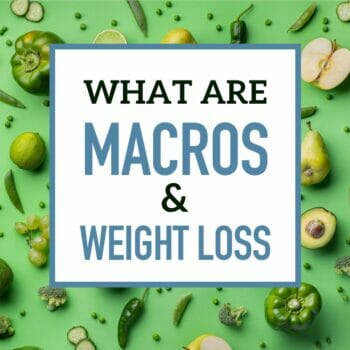 What Are Macros For Weight Loss?
What Are Macros For Weight Loss?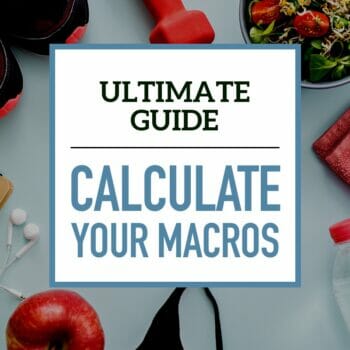 How to Calculate Your Macros for Body Transformation
How to Calculate Your Macros for Body Transformation Drinking Alcohol and Counting Macros
Drinking Alcohol and Counting Macros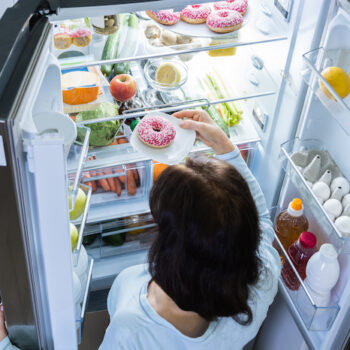 Help, I’m Hungry on a Macros Diet
Help, I’m Hungry on a Macros Diet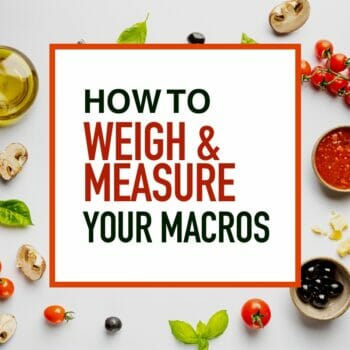 How To Track Macros In the Foods You Eat Painlessly
How To Track Macros In the Foods You Eat Painlessly